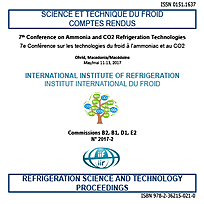
IIR document
Energy consumption for salmon slaughtering processes.
Number: pap. n. 0014
Author(s) : ATES B., WIDELL K. N., NORDTVEDT T. S., et al.
Summary
Today’s slaughtering and processing method for Atlantic salmon (Salmo salar) using large refrigerated seawater (RSW) and buffer tanks before and during a stepwise processing regime has now reached its limits. To overcome this problem, the salmon industry must, like the poultry industry, move towards automated online production, where the animal is quickly processed so all the energy (cooling and transport) can be focused on the meat only and not the surrounding water/ice and carcass. It is of importance to quantify the total energy consumption related to chilling and transport of Atlantic salmon. This enables to foresee and compare the energy requirements, costs and environmental impacts related to existing and new chilling technologies. A modern large slaughter facility in Norway that slaughter up to 125 000 tonnes of Atlantic salmon per year uses RSW tanks for fish cooling with a typical volume of 200-280 m3. This results in a significant amount of energy consumption for refrigeration. The objective of this paper was to describe the current situation at three different salmon slaughterhouses. The energy consumption were estimated and compared. In 2015, the specific energy consumption for these facilities were 105.7, 103.1 and 85.1 kWh/tonne, respectively. The refrigeration systems use ammonia as refrigerant, which is common in food processing industry in Norway.
Available documents
Format PDF
Pages: 8
Available
Public price
20 €
Member price*
Free
* Best rate depending on membership category (see the detailed benefits of individual and corporate memberships).
Details
- Original title: Energy consumption for salmon slaughtering processes.
- Record ID : 30021789
- Languages: English
- Source: 7th Conference on Ammonia and CO2 Refrigeration Technology. Proceedings: Ohrid, North Macedonia, May 11-13, 2017.
- Publication date: 2017/05/11
- DOI: http://dx.doi.org/10.18462/iir.nh3-co2.2017.0014
- Document available for consultation in the library of the IIR headquarters only.
Links
See other articles from the proceedings (42)
See the conference proceedings
Indexing
-
Themes:
Ammonia;
Fish and fish product - Keywords: Slaughterhouse; Energy consumption; Automation; Chilling; R717; Salmon; Norway; Case study
-
Performance simulation of a refrigerated sea wa...
- Author(s) : TOLSTOREBROV I., EIKEVIK T. M., HAFNER A., et al.
- Date : 2017/05/11
- Languages : English
- Source: 7th Conference on Ammonia and CO2 Refrigeration Technology. Proceedings: Ohrid, North Macedonia, May 11-13, 2017.
- Formats : PDF
View record
-
Freezing of mackerel filets in a two-step freez...
- Author(s) : WIDELL K. N., NORDTVEDT T. S.
- Date : 2019/04/11
- Languages : English
- Source: 8th Conference on Ammonia and CO2 Refrigeration Technology. Proceedings: Ohrid, North Macedonia, Avril 11-13, 2019.
- Formats : PDF
View record
-
Improving energy efficiency in seafood freezing...
- Author(s) : SVENDSEN E. S., INDERGÅRD E., BENGSCH J., WIDELL K. N., KOSTER L., NORDTVEDT T. S.
- Date : 2024/06/11
- Languages : English
- Source: 8th IIR International Conference on Sustainability and the Cold Chain. Proceedings: June 9-11 2024
- Formats : PDF
View record
-
Energy consumption of ammonia refrigeration sys...
- Author(s) : SVENDSEN E. S., WIDELL K. N., NORDTVEDT T. S., JAFARZADEH S., GABRIELII C.
- Date : 2021/09/16
- Languages : English
- Source: 9th IIR Conference on Ammonia and CO2 Refrigeration Technologies. Proceedings: Ohrid, North Macedonia, 16-17 September, 2021
- Formats : PDF
View record
-
Chilling of salmon in refrigerated sea water.
- Author(s) : BANTLE M., STAVSET O., NORDTVEDT T. S., et al.
- Date : 2015/08/16
- Languages : English
- Source: Proceedings of the 24th IIR International Congress of Refrigeration: Yokohama, Japan, August 16-22, 2015.
- Formats : PDF
View record
